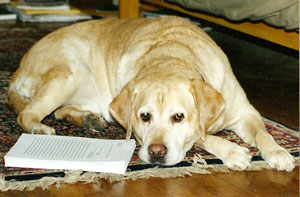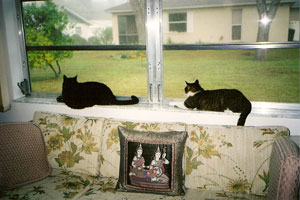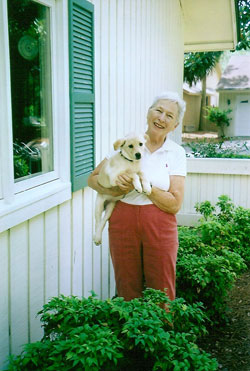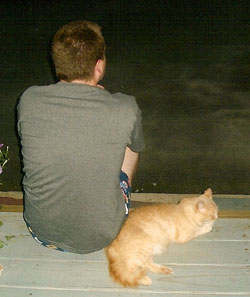| |
|


stared at my computer screen. I needed to get my hero and heroine together, and soon. How hard could it be?
They lived in the same rental house, one in the upstairs apartment, one down. They saw each other a few times a day. Still, Eddie was a rough-and-tumble sort of guy, an auto mechanic who liked his cars and his women fast, sleek, and shiny. Ashley, on the other hand, was a quiet brainiac from Harvard. At this point in the story, they had little in common, and no reason to talk beyond a "hello" on the stairs.
 Then I had an idea. Then I had an idea.
 I brought in a kitten: a pathetic, homeless, meowing kitten caught outside in the rain. It didn't take long for Eddie to dash outside and bring the poor thing in; he wasn't an ogre, after all, and he wouldn't have been able to live with himself had it drowned in the gutter. Then it was just a quick trip upstairs, to ask his neighbor what he was supposed to do with his new pet. Next thing I knew, Ashley was helping Eddie take care of the kitten, and I had chemistry brewing all over the place. I brought in a kitten: a pathetic, homeless, meowing kitten caught outside in the rain. It didn't take long for Eddie to dash outside and bring the poor thing in; he wasn't an ogre, after all, and he wouldn't have been able to live with himself had it drowned in the gutter. Then it was just a quick trip upstairs, to ask his neighbor what he was supposed to do with his new pet. Next thing I knew, Ashley was helping Eddie take care of the kitten, and I had chemistry brewing all over the place.
 This brief scene accomplished two things for me: it showed the reader (and my heroine) that my Alpha hero had a soft side, and it brought my characters together in a believable way. Now, whenever I'm stuck trying to develop a character or move the plot forward, I consider using some animal life. This brief scene accomplished two things for me: it showed the reader (and my heroine) that my Alpha hero had a soft side, and it brought my characters together in a believable way. Now, whenever I'm stuck trying to develop a character or move the plot forward, I consider using some animal life.

|
"...what happens when
our furry, or feathered,
or scaled friends play a
far less prominent part
in our plot?" |
 We can all think of stories where animals play a central role: The Black Stallion, Marley and Me, Moby Dick. In each of these novels, the main characters' worlds revolve around the creatures in them; character development and conflict directly link to the relationship between human and animal. But what happens when our furry, or feathered, or scaled friends play a far less prominent part in our plot? Believe it or not, these creatures can still add dimension to our characters, and even help in maintaining the golden rule of showing, not telling. We can all think of stories where animals play a central role: The Black Stallion, Marley and Me, Moby Dick. In each of these novels, the main characters' worlds revolve around the creatures in them; character development and conflict directly link to the relationship between human and animal. But what happens when our furry, or feathered, or scaled friends play a far less prominent part in our plot? Believe it or not, these creatures can still add dimension to our characters, and even help in maintaining the golden rule of showing, not telling.
 Consider Stephen King's horror classic It. In one early scene, a town bully befriends a neighbor's beagle, gains the animal's trust, and then ultimately poisons it. We see utter moral disregard in this youngster's actions, and when he tortures his own classmates later in the story, we are not surprised at all. Consider Stephen King's horror classic It. In one early scene, a town bully befriends a neighbor's beagle, gains the animal's trust, and then ultimately poisons it. We see utter moral disregard in this youngster's actions, and when he tortures his own classmates later in the story, we are not surprised at all.
 In Jodi Picoult's moving mystery Keeping Faith, Ian Fletcher is the hero with a secretive past who teams up with a mother trying desperately to protect her young daughter. When Ian teaches Faith how to fish one morning, the girl's delight at hooking one on her line becomes the first hint of the connection growing between the characters. In Jodi Picoult's moving mystery Keeping Faith, Ian Fletcher is the hero with a secretive past who teams up with a mother trying desperately to protect her young daughter. When Ian teaches Faith how to fish one morning, the girl's delight at hooking one on her line becomes the first hint of the connection growing between the characters.
"Well, what does it tell
the reader if your
heroine has three cats
that follow her around
the house and sleep
with her every night?" |

|
 How can you use this technique in your own writing? Well, what does it tell the reader if your heroine has three cats that follow her around the house and sleep with her every night? Maybe she's lonely and craves companionship. Or her animals are the only family she has, and she will put them above everything else in her life. So, when she meets a man who is allergic to cats, she must make a choice -- and this gives you the perfect way to show her growth as a character. How can you use this technique in your own writing? Well, what does it tell the reader if your heroine has three cats that follow her around the house and sleep with her every night? Maybe she's lonely and craves companionship. Or her animals are the only family she has, and she will put them above everything else in her life. So, when she meets a man who is allergic to cats, she must make a choice -- and this gives you the perfect way to show her growth as a character.
 What if that same heroine owns a pit bull instead? Maybe her choice in dogs reflects her own fierce independence; she is wary to let anyone else into her life. On the other hand, maybe she deliberately chooses the biggest, most protective dog she can find. She is afraid to live alone since an intruder broke into her home and raped her when she was eighteen. Notice how this choice in a pet can reveal multiple levels of character in a relatively simple way. What if that same heroine owns a pit bull instead? Maybe her choice in dogs reflects her own fierce independence; she is wary to let anyone else into her life. On the other hand, maybe she deliberately chooses the biggest, most protective dog she can find. She is afraid to live alone since an intruder broke into her home and raped her when she was eighteen. Notice how this choice in a pet can reveal multiple levels of character in a relatively simple way.

|
"You can insert animal life into
the pages of your writing in many
different ways. |
 Your characters do not have to own pets for this concept to work, of course. Consider instead how they might react to an injured animal on the side of the road. Perhaps your hero is a compassionate father figure who stops on his way to work to tend to it. Or maybe he's a crafty businessman who speeds up and smiles, thinking, "Good. One less nuisance in the world." On the other hand, maybe he is brilliant and calculating, planning each move in his life like a chess game, so he turns his car around when he sees a news camera heading to the scene. Your characters do not have to own pets for this concept to work, of course. Consider instead how they might react to an injured animal on the side of the road. Perhaps your hero is a compassionate father figure who stops on his way to work to tend to it. Or maybe he's a crafty businessman who speeds up and smiles, thinking, "Good. One less nuisance in the world." On the other hand, maybe he is brilliant and calculating, planning each move in his life like a chess game, so he turns his car around when he sees a news camera heading to the scene.

 You can insert animal life into the pages of your writing in many different ways. When your heroine heads out for her morning run, for example, does she notice the birds building a nest in her maple tree, welcoming the start of spring? Or does she curse the fact that they are using her new Mercedes as a toilet? Maybe she calls the exterminator when she sees a woodchuck dart across the grass, revealing her distaste for anything that disrupts her perfect lawn and her perfect life. Or conversely, she kneels down with a carrot in hand and makes a clucking noise to get its attention, showing the reader her protective, nurturing side. You can insert animal life into the pages of your writing in many different ways. When your heroine heads out for her morning run, for example, does she notice the birds building a nest in her maple tree, welcoming the start of spring? Or does she curse the fact that they are using her new Mercedes as a toilet? Maybe she calls the exterminator when she sees a woodchuck dart across the grass, revealing her distaste for anything that disrupts her perfect lawn and her perfect life. Or conversely, she kneels down with a carrot in hand and makes a clucking noise to get its attention, showing the reader her protective, nurturing side.

|
"Each of these reactions reveal
something very distinctive
about Jake, in the span of a
few short sentences." |
 Introductions are another instance where you can use animal life to create a multi-layered character. Let's say you've introduced your Alpha-male hero, Jake, to the reader. Jake is a towering, muscular guy who lives by himself and speaks in short, curt sentences. Through a telephone conversation with his lawyer, we discover that he suffered the devastating loss of his wife and child in a car accident. He moves out to a rural area without any neighbors, and works the night shift so he doesn't have to deal with any people. Introductions are another instance where you can use animal life to create a multi-layered character. Let's say you've introduced your Alpha-male hero, Jake, to the reader. Jake is a towering, muscular guy who lives by himself and speaks in short, curt sentences. Through a telephone conversation with his lawyer, we discover that he suffered the devastating loss of his wife and child in a car accident. He moves out to a rural area without any neighbors, and works the night shift so he doesn't have to deal with any people.
 Okay, now that your readers know the basics about him, imagine how you might add even more flavor if Jake walks out his back door and sees a family of rabbits in his yard. What does he do? Maybe he reaches for his gun; because anything living reminds him of his loved ones, who are not. Or maybe he goes back inside and finds some leftover vegetables, showing the reader that he still has a soft spot underneath his sad, gruff exterior. Perhaps after he feeds them, he remains on the porch, eyeing the edge of the woods to make sure no predators lurk nearby. This might be the first step in Jake's healing process, his ability to let himself care for something small and helpless. On the other hand, maybe it's early in the story, and he's not ready to feel compassion for another living creature yet. So instead, he turns around and slams the door behind him, putting the animals out of view and out of his mind. Okay, now that your readers know the basics about him, imagine how you might add even more flavor if Jake walks out his back door and sees a family of rabbits in his yard. What does he do? Maybe he reaches for his gun; because anything living reminds him of his loved ones, who are not. Or maybe he goes back inside and finds some leftover vegetables, showing the reader that he still has a soft spot underneath his sad, gruff exterior. Perhaps after he feeds them, he remains on the porch, eyeing the edge of the woods to make sure no predators lurk nearby. This might be the first step in Jake's healing process, his ability to let himself care for something small and helpless. On the other hand, maybe it's early in the story, and he's not ready to feel compassion for another living creature yet. So instead, he turns around and slams the door behind him, putting the animals out of view and out of his mind.
 Each of these reactions reveal something very distinctive about Jake, in the span of a few short sentences. The moment may be gone in a paragraph or so, and he may never see those rabbits again, but the scene has done wonders to show the reader another facet of his character. Each of these reactions reveal something very distinctive about Jake, in the span of a few short sentences. The moment may be gone in a paragraph or so, and he may never see those rabbits again, but the scene has done wonders to show the reader another facet of his character.

 Mahatmas Gandhi once said, "The greatness of a nation and its moral progress can be judged by the way its animals are treated." Certainly, this concept can apply to the characters in the worlds we create as well. So if you're facing a struggle in your character building, or a downright screeching halt, consider calling man's best friend to your rescue. You just might find the inspiration you need. Mahatmas Gandhi once said, "The greatness of a nation and its moral progress can be judged by the way its animals are treated." Certainly, this concept can apply to the characters in the worlds we create as well. So if you're facing a struggle in your character building, or a downright screeching halt, consider calling man's best friend to your rescue. You just might find the inspiration you need.
Good Luck!

----------------------------------------------------
Allie Boniface is a writer and high school English teacher living with her husband in the northern New York City suburbs. A member of Romance Writers of America and Writers' Village University, she has published short works with both Runners' World magazine and WriterOnline.com. Her romance novel Paradise, USA, will be available as a serial publication through www.VirtualTales.com in March 2007. Visit Allie at her website, www.allieboniface.com, or find out what's on her mind today at her blog, www.allieboniface.blogspot.com. |